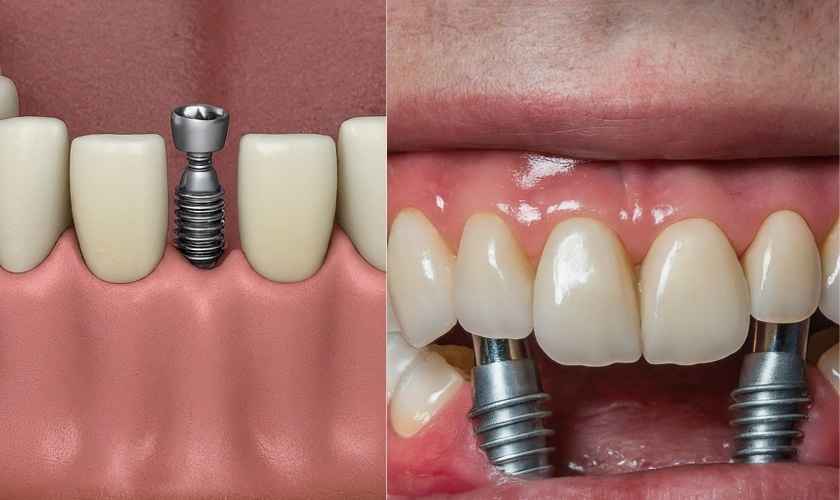Things about Dental Sense
Things about Dental Sense
Blog Article
Our Dental Sense PDFs
Table of ContentsThe Best Guide To Dental SenseWhat Does Dental Sense Mean?Top Guidelines Of Dental SenseThe Only Guide for Dental Sense
are medical gadgets surgically implanted into the jaw to restore an individual's capacity to eat or their appearance. They provide support for fabricated (phony) teeth, such as crowns, bridges, or dentures. When a tooth is lost because of injury or illness, a person can experience difficulties such as fast bone loss, defective speech, or changes to chewing patterns that cause discomfort.Dental implant systems include a dental implant body and dental implant abutment and might likewise consist of an abutment addiction screw. Front tooth filling. The oral implant body is operatively inserted in the jawbone in area of the tooth's root. The dental implant joint is generally connected to the implant body by the joint addiction screw and prolongs with gums into the mouth to support the affixed synthetic teeth
(https://giphy.com/channel/dentalsense1)Framework of The Dental Implant System choosing dental implants, talk to your oral copyright regarding the potential benefits and risks, and whether you are a candidate for the procedure. Things to take into consideration: Your total health is an essential consider establishing whether you are a great candidate for oral implants, for how long it will certainly take to heal, and just how long the dental implant might remain in place.
Cigarette smoking might influence the recovery procedure and lower the long-lasting success of the dental implant. The healing process for the dental implant body might take several months or longer, during which time you normally have a momentary abutment in location of the tooth. the oral implant treatment: Thoroughly follow the dental health directions provided to you by your dental service provider.
The Only Guide for Dental Sense
Implant failing can lead to the need for an additional operation to deal with or replace the dental implant system. Recovers the capacity to chew Recovers aesthetic look Helps maintain the jawbone from shrinking because of bone loss Maintains the health of the surrounding bone and periodontals Aids keep nearby (nearby) teeth steady Boosts high quality of life Damage to bordering natural teeth during dental implant placement Injury to the surrounding tissues throughout surgery, such as sinus perforation Injury during surgical treatment (for instance, fracture of surrounding jawbone) Poor feature, such as really feeling like the teeth do not bite with each other usually An experience that the tooth hangs or twisting in position resulting from a joint screw loosening Implant body failure (looseness of the dental implant body) due to systemic infection, which might be more probable in clients with unrestrained diabetics issues as a result of local infection in bone and gum tissues sustaining the implant body because of postponed recovery, which might be most likely in people that smoke Trouble cleaning up the gums around the implant, leading to inadequate dental health Without treatment periodontal disease Post-surgical tingling as a result of nerve impingement or damage Always notify health and wellness treatment service providers and imaging professionals that you have dental implants before any type of magnetic vibration imaging (MRI) or x-ray treatments.
FDA is not familiar with any negative occasions reported for MRI or x-ray procedures with dental implants. Dental implants systems are normally made of products that follow international consensus criteria of the International Organization for Standardization (ISO) or ASTM International. These criteria have details of what makes a safe product.

A dental implant is a framework that changes a missing out on tooth. With screw-like tools, the specialist inserts an implant into the jawbone, and it acts as an anchor for a synthetic tooth, called a crown.
The Greatest Guide To Dental Sense
Some people are not qualified for oral implant surgical procedure. It is for dental specialists to operate on people with: severe illnessuncontrollable metabolic diseasebone or soft cells disease or infectionIf these concerns are settled, an individual can have the surgical procedure. In, dental doctors abstain from operating individuals with: If people with any one of the above undertake dental implant surgical treatment, there is a higher risk of the implant failing.

Oral dental implant surgical procedure is a customized procedure. Give you time to recover. Connect the article and last crown, bridge or denture.
Next off, your doctor will very carefully put the oral implant into your jaw. If your implant is near the front of your mouth, your dental practitioner will certainly make a momentary tooth for you to use up until you recover.
The Greatest Guide To Dental Sense
Your service provider can tell you what to expect in your situation. Throughout the recovery stage, your jawbone must fuse to the dental implant. This procedure, called osseointegration, is vital for stability and long-term success. This procedure can take anywhere from 3 to 9 months. In many cases, it might take much longer.
When your dental implant heals, your dental practitioner can connect the joint (small connector blog post) and your last reconstruction (crown, bridge or denture). This typically takes about one hour to finish and may require a 2nd minor surgical procedure. You shouldn't feel any type of pain throughout your oral implant treatment because your copyright will make use of drug to numb your periodontals.
Report this page